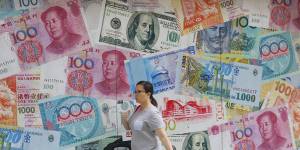Another blow to the global outlook and commodity prices is expected this week when the Federal Reserve Board’s Open Market Committee meets again and is expected to raise US interest rates by at least another 75 basis points,the third such increase in succession.

China is the biggest consumer of commodities but its COVID-zero policies,the fissures in its property sector and the unsettling effects of its crackdowns on its technology and education sectors have slowed its growth almost to a halt.Getty
If it follows through on market expectations the Fed will have raised US rates by three percentage points this year,with another rate rise to come before the end of this year and probably at least one more increase in the early months of next year.
The Fed’s aggression is having spillover effects into currency markets – after climbing nearly 15 per cent against a basket of its major trading partners’ currencies this year – and consequently into the values of commodities that are priced in US dollars.
With the European Central Bank,and others,also committed to raising their interest rates to combat similarly elevated inflation rates,the rising tide of global interest rates by itself would depress economic activity and therefore the demand for commodities.
Adding the appreciation of the US dollar to that mix amplifies the negative influences by effectively raising the cost of commodities for economies,mainly China and the developing economies,that process them into goods. For obvious macroeconomic reasons,there is a strong inverse correlation between the dollar and commodity prices.
It also raises the cost of debt for those commodity importers. Those economies with debt exposed to the US dollar face a steep increase in servicing and repayment costs. The international financial agencies are already warning of the potential for crises in less developed economies as that combination of slowing global growth and a strengthening dollar bites.
The weakness in China’s economy is another influence on the 14 per cent dive in the Bloomberg Commodity Index from its high point this year in June.
China is the biggest consumer of commodities but its COVID-zero policies,the fissures in its property sector and the unsettling effects of its crackdowns on its technology and education sectors have slowed its growth almost to a halt.
The surge in the value of the US dollar,which has seen its currency sliding within a smidgen of the seven-yuan-to-the-dollar level (it momentarily dropped past that level last week) that China has defended in the past.
The Chinese authorities would be less concerned about the inflationary effects of a nine per cent depreciation in its currency against the dollar this year than the impact on the inputs into its vast industrial base,with the currency effects muffling the benefits of the lower commodity prices.

Even the price of gold,once regarded as the great hedge against inflation,has tumbled this year.Louie Douvis
The rise in real interest rates around the world has also had another effect. Since the start of this century commodities have increasingly become a financial asset class – they have been “financialised” -- as investment banks,hedge funds and,via exchange-traded funds,other institutions and individuals have seen them as an alternative to equities,bonds and property.
Increasingly the degree of diversification they once offered has been reduced and their performance has been more closely correlated with other assets classes. They have also become more sensitive to movements in interest rates and the availability of liquidity because of the funding costs associated with holding physical inventories.
As rates have risen and central banks have started to withdraw liquidity from financial markets that they overdosed with cheap liquidity at the onset of the pandemic,financial investors have started to retreat to the sidelines. Commodity markets have consequently become more illiquid and volatile.
Even the price of gold,once regarded as the great hedge against inflation,has tumbled this year. In March,it was trading around $US2043 an ounce. It’s now priced about 18 per cent lower,around $US1680 an ounce.
(Bitcoin,the other great supposed inflation hedge and diversifier,has imploded along with other higher risk assets. From almost $US70,000 last November the price has plunged to less than $US20,000. It is currently trading around $US19,400).
Copper,regarded as the metal most sensitive to the economic outlook,has slumped about 28 per cent from this year’s March high.
Iron ore – the commodity of most significance for the Australian economy – was trading above $US150 a tonne as recently as May. It’s now below $US110 a tonne.

The surging US dollar has worrying ripple effects for the global economy.AP
The apparent coincidence of some commodities peaking in March isn’t actually a coincidence. It was in March that the Fed started this cycle of rising interest rates and announced its plans for shrinking its balance sheet (and withdrawing liquidity from financial markets) by allowing the massive stockpiles of bonds and mortgages it accumulated through its quantitative easing programs to run off.
Russia’s invasion of Ukraine in late February may also have been an influence,particularly on the volatility of commodity prices.
It sent energy and agricultural commodity prices soaring and was clearly grim news for Europe’s outlook. Both energy (particularly oil) and agricultural commodity prices have since fallen back significantly – oil is down 29 per cent from its March peak – but remain significantly above their pre-invasion levels.
It’s an by the Fed’s efforts to contain an inflation rate that hasn’t responded to the rate rises imposed so far.
It appears inevitable Europe, that is being exacerbated by a currency near record lows,will experience one.
China may avoid recession but its growth rate is,excluding the initial impact of the pandemic,as weak as it has been in decades.
Japan’s also being throttled by a more than 20 per cent plunge in the value of the yen against the dollar this year.
In the circumstances,it would have been surprising if commodity prices had held up. If they perform as expected,it won’t be until the end of this rate cycle is in sight before they,and subsequently (commodities are lead indicators) the global economy,experience any real revival.
The Business Briefing newsletter delivers major stories,exclusive coverage and expert opinion..